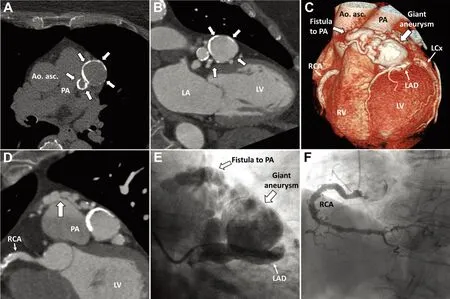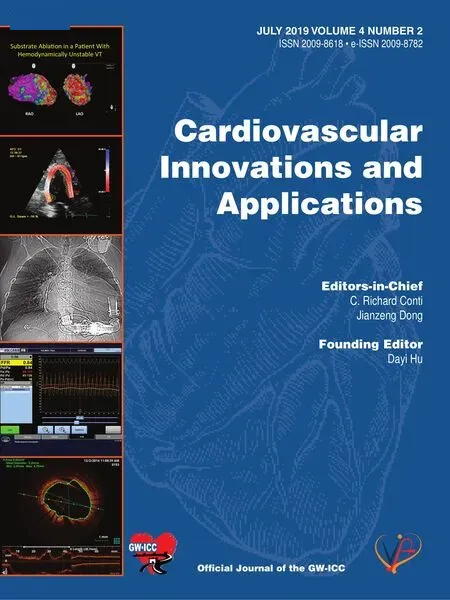Giant Aneurysm of a Coronary-Pulmonary Artery Fistula:A Rare Cause of a Diastolic Murmur
Andreas Seitz ,Sophie Schäfer ,Maik Backes ,Heiko Mahrholdt and PeterOng
1 Department of Cardiology,Robert-Bosch-Krankenhaus,Auerbachstr.110,70376 Stuttgart,Germany
2 Department of Radiology,Robert-Bosch-Krankenhaus,Auerbachstr.110,70376 Stuttgart,Germany
Abstract
A coronary-pulmonary artery fistula with giant aneurysmal dilatation is an extremely rare clinical constellation.The natural course of this disease and the incidence of complications are unknown.Hence,optimal treatment,particularly in asymptomatic patients,is still a matter of debate.Here we report a case of a 71-year-old asymptomatic woman with a diastolic murmur.Comprehensive cardiovascular assessments including cardiac computed tomography and invasive coronary angiography revealed a coronary-pulmonary artery fistula with giant aneurysmal dilatation.The patient was managed conservatively and has now been followed up for 5 years without any events.
Keywords: coronary anomaly;coronary fistula;giant aneurysm;pulmonary artery;diastolic murmur
Introduction
Coronary-pulmonary artery fistulas are rare congenital or acquired coronary anomalies that are reported in 0.1- 0.2% of patients undergoing coronary angiography [1,2].The clinical presentation of affected patients is variable,including asymptomatic as well as symptomatic patients (e.g.,chest pain or dyspnea),and the most common finding on physical examination is a murmur [3].A coronary artery aneurysm is another coronary anomaly indicating a greater than 1.5-fold localized dilatation of the coronary artery diameter compared with an adjacent normal segment.Very large coronary aneurysms with a diameter greater than 2 cm are rare,and are also referred to as “ giant” aneurysms.
Case Description

Figure 1:Thoracic computed tomography revealed peripherally calcified mediastinal masses close to the pulmonary artery (PA) trunk (A).Coronary computed tomography angiography depicted a tortuous fistula from the left anterior descending coronary artery (LAD) to the main PA feeding two large aneurysms (B- D;the arrow in D shows drainage into the PA).The findings were confirmed by invasive coronary angiography,which in addition demonstrated a diffuse coronary artery ectasia without significant epicardial stenosis (E and F;see also Online Resources 1 and 2).Ao.asc.ascending aorta;LA,left atrium;LCx,left circumflex artery;LV,left ventricle;RCA,right coronary artery.
A 71-year-old woman was referred to our institution for workup of unclear mediastinal masses with peripheral calcifications incidentally noticed on a thoracic computed tomography (CT) scan that was performed for a prolonged respiratory tract infection ( Figure 1A ,white arrows).At the time of admission,the patient was asymptomatic and her vital parameters were stable (heart rate 73 bpm,blood pressure 140/75 mmHg).There was no history of coronary artery disease or structural heart disease despite a diastolic murmur loudest in the right parasternal area (second intercostal space),which had been known for more than 20 years although routine transthoracic echocardiography (the latest performed 2 months before the CT scan) findings were normal.The cardiovascular risk profile comprised a history of essential arterial hypertension without pharmacological treatment and high blood cholesterol concentrations (total cholesterol 338 mg/dL,LDL cholesterol 231 mg/dL).For further evaluation of the mediastinal masses,coronary CT angiography was performed and revealed a tortuous fistula from the left anterior descending coronary artery to the main pulmonary artery feeding two large and peripherally calcified aneurysms (13 mm and 28 mm in diameter;Figure 1B- D;the arrow in Figure 1D shows drainage into the pulmonary artery).Invasive coronary angiography confirmed the findings and further demonstrated diffuse coronary artery ectasia and plaques without signifi-cant epicardial coronary artery stenoses ( Figure 1E and F and Online Resources 1 and 2).
Discussion and Follow-up
A recently published review of 103 patients with coronary-pulmonary artery fistula found coexisting aneurysms of the fistula itself or its feeding coronary artery in almost 20% of these patients [3].However,giant aneurysmal dilatation ( > 2 cm) of the fistula is extremely rare [4 - 7].Most of the previously reported cases of coronary-pulmonary artery fistulas with aneurysmal dilatation underwent surgical resection/ligation or transcatheter closure because of clinical symptoms or the risk of future complications such as rupture and/or thromboembolic events [8].However,the natural course of the disease and the true incidence of complications remain unclear.Hence,optimal treatment of aneurysmal coronary-pulmonary artery fistulas in asymptomatic patients is still a matter of debate [5,9,10].Here we reported the incidental finding of a coronary-pulmonary fistula with giant aneurysmal dilatation in an asymptomatic patient where no surgical or interventional treatment was pursued.Conservative management with aspirin and statin treatment was favored because of the lack of symptoms and the almost circumferential calcifi-cations of the aneurysms suggesting long-standing presence and stability.At the 5-year follow-up,the patient was asymptomatic.
Conflict of Interests
The authors declare that they have no conflicts of interest.
Funding
This work was funded by the Robert Bosch Stiftung,Stuttgart,Germany,and the Berthold Leibinger Stiftung,Ditzingen,Germany.
REFERENCES
1.Said SA,Landman GH.Coronarypulmonary fistula:long-term follow-up in operated and nonoperated patients.Int J Cardiol 1990;27(2):203- 10.
2.Vavuranakis M,Bush CA,Boudoulas H.Coronary artery fistulas in adults:incidence,angiographic characteristics,natural history.Cathet Cardiovasc Diagn 1995;35(2):116- 20.
3.Verdini D,Vargas D,Kuo A,Ghoshhajra B,Kim P,Murillo H,et al.Coronary-pulmonary artery fistulas:a systematic review.J Thorac Imaging 2016;31(6):380- 90.
4.Niimura H,Tei C.Image in clinical medicine.Coronary-artery fistula with a giant aneurysm.N Engl J Med 2002;346(16):1211.
5.Gandy KL,Rebeiz AG,Wang A,Jaggers JJ.Left main coronary artery-to-pulmonary artery fistula with severe aneurysmal dilatation.Ann Thorac Surg 2004;77(3):1081- 3.
6.Ozaki N,Wakita N,Inoue K,Yamada A.Surgical repair of coronary artery to pulmonary artery fistula with aneurysms.Eur J Cardiothorac Surg 2009;35(6):1089- 90.
7.Okita Y,Miki S,Kusuhara K,Ueda Y,Tahata T,Sakai T,et al.Aneurysm of coronary arteriovenous fistula presenting as a calcified mediastinal mass.Ann Thorac Surg 1992;54(4):771- 3.
8.Sakao T,Tsunooka N,Nakagawa H,Kajiwara S.[Ruptured saccular aneurysm of a coronary artery to pulmonary artery fistula associated with cardiac tamponade].Kyobu Geka 2000;53(8 Suppl):684- 6.
9.Kim MS,Jung JI,Chun HJ.Coronary to pulmonary artery fistula:morphologic features at multidetector CT.Int J Cardiovasc Imaging 2010;26(Suppl 2):273- 80.
10.Izumi K,Hisata Y,Hazam S.Surgical repair for a coronary-pulmonary artery fistula with a saccular aneurysm of the coronary artery.Ann Thorac Cardiovasc Surg 2009;15(3):194- 7.
 Cardiovascular Innovations and Applications2019年4期
Cardiovascular Innovations and Applications2019年4期
- Cardiovascular Innovations and Applications的其它文章
- Cardiovascular Innovations and Applications
- Superior Vena Cava Occlusion as a Complication of Transvenous Cardiac Device Implantation:A Case Report and Brief Review
- The Relationship Between Mean Platelet Volume and ln-Hospital Mortality in Geriatric Patients with ST Segment Elevation Myocardial lnfarction Who Underwent Primary Percutaneous Coronary lntervention
- Ultrasound:The Potential Power for Cardiovascular Disease Therapy
- Predictive Value of Resting Pd/Pa for Fractional Flow Reserve Assessed with Monorail Pressure Microcatheter in Real-World Practice
- Systemic Vasculitis:An Important and Underestimated Cause of Malignant Hypertension
